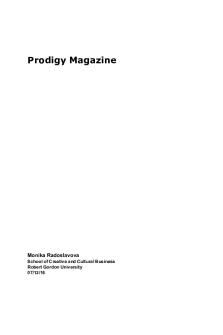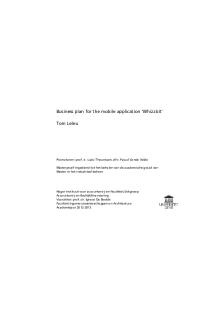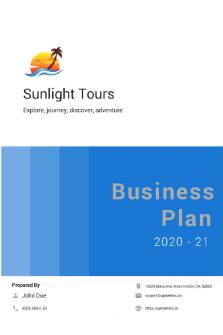Magazine business plan - Example PDF

| Title | Magazine business plan - Example |
|---|---|
| Course | The Media Business |
| Institution | The Robert Gordon University |
| Pages | 13 |
| File Size | 374 KB |
| File Type | |
| Total Downloads | 32 |
| Total Views | 160 |
Summary
An example business plan for the launch of a new magazine as part of CW....
Description
Prodigy Magazine
Monika Radoslavova School of Creative and Cultural Business Robert Gordon University 07/12/16
Prodigy Magazine
Monika Radoslavova School of Creative and Cultural Business Robert Gordon University 07/12/16
Summary
Prodigy magazine is a monthly art and lifestyle magazine. Its main focus is underground and contemporary art but it also covers a variety of other topics such as performance art, dance, events and technology. The magazine is available in print version and will also have a website where additional information can be found. Prodigy will stand out with its unique design which will turn it into a future collector’s item. The concept behind the magazine is to portray underground and alternative arts in a good light and break the stereotypes associated with underground culture. Prodigy magazine is targeted at teenagers and young adults and will use many interactive methods to communicate with its audience and make sure the demands are met. Readers will also be able to participate in the content creation process by submitting their own artworks, questions or ideas through the company website. The magazine will host many competitions where readers could win prizes or have their artwork featured. One of Prodigy’s aims is to encourage creativity and teach the younger audience the ability to appreciate art in all its forms. Another long-term goal for the magazine is to establish a charity foundation that will aid aspiring artists. A part of the annual turnover will be donated to the cause to help finance education or participation in competitions and events. Because of its effective marketing strategy, Prodigy has the potential to become a leader in the magazine industry. Once it builds a loyal customer base within the UK, a global expansion of the business is also a possibility.
i
Table of Contents List of Content
Page
Summary…………………………………………………………………………………….....…… i Introduction…………………………………………………………………………………….……. 1 Analysis of Today’s Magazine Market……………………………………………….…………… 1 SWOT Analysis Details of Target Market………………………………………………………...…………………. 2 Competition………………………………………………………………………...……………….. 3 Identity and Image………………………………………………………………………………….. 3 Unique Selling Points ……………………………………………………………………………… 4 Digital Aspects Interactive Elements Content………………………………………………………………………………………………. 4 Launch of Magazine………………………………………………………………………………... 5 Possible Future Activities……………………………………………………...…………………... 6 Organizational Structure………………………………………………………………………...…. 6 Conclusion…………………………………………………………………………………………… 7 Appendix A: Logo of Prodigy magazine………………………………...………………………... 8 Appendix B: Organizational Structure ………………………………...……………...………….. 9 References………………………………………………………………………………………….. 10
ii
Introduction Over the last few years, there has been a significant decline in the sale of print magazines and digitalization is one of the main causes. This report presents an idea for a monthly print magazine that will take advantage of the digital opportunities available and thus have better communication with readers. In addition to its effective digital marketing strategy, Prodigy magazine will stand out with interesting and informative content in the field of underground and alternative art. Its attention-grabbing design will distinguish it from competitors and also suggest that Prodigy is an active advocate for arts.
Analysis of today’s magazine market According to Mintel (2015), there has been a fairly consistent decline in magazine print circulation over the last five years, with a further 7% fall estimated during 2015. The study also forecasts a further 31% drop over the following five years. When it comes to the circulation of digital editions, there has been a significant increase of 33% over the year 2014 alone. The study also found that print versions of magazines continue to dominate, as 52% of people who took part in the survey had read a print magazine in the last 6 months, compared to only 19% who had read a digital version. The information found suggests that “people do have an affinity for the format and enjoy the experience of having a print product in their hands” (Mintel, 2015, p.2). The study also indicates some of the most popular magazine types and the format in which the readers had accessed them (Figure 1).
Furthermore, Mintel’s analysis reveals that people consume digital magazines differently than the way print magazines are traditionally read – 23% of readers prefer articles 1
in digital magazines to be short and take less than 5 minutes to read. Another 21% have indicated that they would like digital magazines to have more interactive content. Overall, the study suggests that “far more needs to be done to regularly reach out to consumers, such as through more extensive and targeted social media campaigns” (Mintel, 2015, p.3).
SWOT Analysis Strengths:
Innovative approach to marketing Informative and interesting content Attention-grabbing design Interactive elements
Weaknesses:
Lack of reputation Lack of funding
Opportunities:
Revive interest in print magazines Establish relationships with business partners Diversify the business
Threats:
Overall decline in magazine market Competitors Digitalization of media
Details of target market Prodigy magazine is generally targeted at older adolescent/young adult readers (1524 years of age), who show an interest in underground culture and arts. Reading is reported to be a moderately popular activity among teenagers, as 51% of interviewed students say they enjoy reading as a past-time activity (Nippold, Duthie & Larsen, 2005). Magazines proved to be the most popular reading materials for teenagers, however, “older students showed a stronger preference than younger ones for magazines” (Nippold et al., 2005, p. 98).
2
Competition There are many art and lifestyle magazines currently in circulation. Most of them are not available in print versions in the UK but can be purchased online. Some of the most popular ones include:
Hi-Fructose – a quarterly print art magazine, founded in 2005. The magazine “showcases an amalgamation of new contemporary, emerging as well distinguished artists, with a spotlight on awe inspiring spectacles from round the world” (Hi-Fructose Magazine, n.d.). Hi-Fructose is distributed internationally in major bookstore chains, galleries, boutiques, etc. Juxtapoz – a monthly contemporary and underground art magazine, based in San Francisco, California. The magazine was established in 1994 by a group of artists and its aim was to connect modern genres like street art, illustration and graffiti. As of 2009, the magazine had the largest circulation of any art magazine in the US. Juxtapoz is available globally as an online digital subscription. Carpazine – a monthly magazine which showcases underground graffiti and punk art, established in New York, USA. The magazine is available globally and can be purchased online. Art Monthly – established in 1976, it is one of UK’s leading contemporary visual art magazines. It is published 10 times a year and is “the only magazine with regular columns on artists’ books and multiples” (Art monthly, n.d.) Flux – first launched in Manchester in 1997, Flux showcases music, arts and fashion and is considered a high-end style and culture magazine. It is distributed across the UK and internationally.
Having in mind the content of these magazines and their printing periods, Prodigy magazine will try to differentiate itself from the competitors and offer a variety of unique topics.
Identity and image Prodigy magazine celebrates urban underground and alternative art. Its goal is to portray the underground arts in a new light, which will hopefully encourage more readers to partake, and also change the stereotypes associated with it. We want to encourage freedom and creativity among our younger audience and teach them the ability to appreciate what is beautiful. Research has shown that logos create symbolic associations with the brand and thus influence brand image among consumers (Fajardo, 2016). Prodigy magazine’s logo is easily recognisable and will set it apart from the other competitors in the market (see Appendix A). One of our main focuses when creating the magazine will be its design which will hopefully turn it into a collector’s item.
3
Unique selling points Digital aspects It is vital for a good company to successfully communicate with its audience. Having in mind the fact that our target audience is mainly young people, the easiest way to reach them would be through the Internet – via Social media and the magazine website. Prodigy magazine will be active on most major social platforms (Twitter, Facebook, Instagram, Snapchat, Youtube, etc), giving readers a number of options to get in touch with the editors and also stay informed. An innovative approach in engaging with the consumers will be the implementation of Quick Response (QR) codes. Such codes will be placed within articles and will give further information on the topic. A reader could scan the QR code with their smartphone which will then open a webpage with additional materials. This approach will be useful, for example, when incorporating behind the scenes footage from social events or redirecting the reader to an artist’s portfolio. Those webpages will only be reached through the provided QR codes giving the consumer access to exclusive materials which cannot be found elsewhere.
Interactive elements In order for readers to fully engage with the magazine’s content, we will offer a variety of ways for them to connect with us and even have their own art featured. Everyone will have the chance to submit their own artworks and/or ideas of what topics we should include in our next issue. This will happen through our website where readers can fill out our contact form and put their ideas across. Every month Prodigy magazine will give readers a topic on which they can showcase their artistic skills and compete for the chance to have their work featured in the new issue. The topics will consist of a single word (e.g. “water”, “fight”, “love”, etc) and the contestants’ challenge will be to illustrate the word in an artistic way. This could be anything from graffiti to a photographic image, a song/music piece or even dance/performance art. The winner will be selected through online voting on our website, the link to which will be featured on all of our social network profiles. Another competition, this time aimed at observance rather than creativity, is the “Logo Hunt”. Our logo will be hidden in an image and it’s the reader’s goal to find it and send us the page number. The winner will be selected at random and will win different prizes, ranging from a free copy of the next issue to various Prodigy merchandise.
Content According to Mintel (2015), “it may be beneficial to magazines to set a higher bar, using high content standards and a more “intellectual” tone as a selling point” (p. 4). We aim for our magazine to attract readers not only with its graphic appearance but also with entertaining as well as informative articles. Prodigy magazine will try to capture the consumer’s attention with eye-catching images as a centrepiece and shorter, easy to read articles. Our magazine will cover a majority of topics such as arts, activities, events, technology. We will focus on the innovations which we expect to take over the market in the future. When it comes to arts, our main objective is to break the stereotypes associated with 4
underground culture and portray it in a good light. We want to convey the message that art is freedom and there should be no censorship in it. Prodigy will be divided into the following categories: Art This category will be the main focus of Prodigy magazine. It will give more insight on topics such as tattoos, contemporary art, graffiti and various types of street art as well as the newest trends in these areas. Some example article topics are: Graffiti – origin and history, exploration of various styles and techniques, interviews with acclaimed artists, legal issues and partial legalisation, etc. Tattoos – origins, interviews with tattoo artists, tips on finding the right artist, tattoo after-care, new trends (e.g. watercolour tattoos, “stick and poke”, white ink, etc.) Contemporary art – information about exhibitions, popular artists, latest trends, innovative techniques Action This section will cover a variety of activities such as break dancing, pop locking, skateboarding, BMX racing, performance arts, etc. Along with the usual interviews with performers/athletes and some background knowledge on the activity, readers will also be given information on how and where to start in case they want to try them out for themselves. QR codes will be printed alongside the article and will offer quick access to videos showing the activity. Events Prodigy magazine will promote different events such as music festivals, concerts, art installations, art fairs, etc. taking place in bigger cities within the UK. Additional information on tickets, transport and accommodation will also be available. Technology This category will give insight into the ever-changing world of technology. It will present readers with articles discussing the latest tech products and, if possible, reviews. Example products are the Google Glass, Snapchat Spectacles, 3D printers, Apple watch, 4K television, etc. Readers’ submissions As mentioned earlier, all readers will be able to submit their own artworks, questions or ideas. They can also send us materials including videos, photographs or their own articles for a chance to be featured in the magazine.
Launch of magazine Prior to its launch, Prodigy magazine will carefully build up its presence on popular social media platforms (e.g. Facebook, Youtube, Twitter, etc.). Since the magazine is targeted at teenagers/young adults, we believe this approach will be highly effective as well as convenient in terms of reaching out to our audience and informing them about our product. As a part of our advertising campaign, we will produce a series of short videos (trailers) which will set the scene of what readers can expect from the magazine. These will be released months before the official launch and will build suspense and arouse curiosity in consumers. We will also reach out to different people within the art community for support. 5
On the day of the launch, Prodigy magazine will have street artists perform their acts in numerous locations in the UK. Onlookers will be encouraged to take photos or videos of the performances and share them online with the hashtag “#prodigy”. That way, even more attention will be drawn to the magazine. Copies of the first issue will be available for sale at the locations of the acts, as well as in all bookshops and newsagents.
Possible future activities It is difficult to predict the future of Prodigy magazine, however, we will attempt to use the momentum it gathers to advocate art and show our younger audience the benefits of it. A possible way to achieve that is to annually host workshops or organize art festivals in order to endorse creativity among the youth. In the distant future, it is possible to set up a foundation to aid aspiring artists. A part of the annual turnover would be donated to the cause to help finance education and/or participation in global competitions or events. A potential way to increase profit is to sell by-products such as Prodigy merchandise T-shirts, sweatshirts, key chains, coffee mugs, etc. This will only be done if there is a demand for that type of product among our readers and that is something which will be determined by further marketing research.
Structure of magazine The magazine’s staff will consist of around 12 employees working in 4 departments (IT, PR, Graphic design, Content creation) and an Editor-in-chief who will head all departments and delegate tasks (see Appendix B). Some of the duties our staff will have are as follows:
Editor-in-chief – editing content, proofreading, contributing editorial pieces, ensuring final draft is complete, motivating and developing staff, etc.; PR team – provide the link between the magazine and the public or other organisations, carry out administrative duties; IT team – maintaining the company website, managing social media accounts; Graphic designers – creating and managing all visual content; Head Writer – leading the team of writers, will be responsible for all written content Writers – performing research on various topics, writing articles Reporters & Photographer – covering social events, conducting interviews
The magazine headquarters will be situated in Glasgow and will rent an office that suits the company’s needs.
6
Conclusion Due to its effective marketing strategy, quality content and distinctive design, Prodigy magazine has the prospects of becoming a successful competitor in the magazine market. Giving the audience the ability to participate in the content creation process will make the content relevant and well-tailored to the readers’ demands. This will help the magazine gain a good reputation and create a loyal relationship with customers. Once Prodigy manages to build and maintain a local customer base, an international expansion is also a possibility. A long-term goal for Prodigy magazine is to establish itself not only as a leader in the magazine industry but to also become an active arts advocate, promoting freedom of self-expression.
7
Appendix A: Logo of Prodigy magazine
8
Appendix B: Organizational structure of Prodigy magazine
9
References Artmonthly.co.uk. (n.d.). Art Monthly : About. [online] Available at: http://www.artmonthly.co.uk/magazine/site/about [Accessed 28 Nov. 2016]. Carpazine. (n.d.). [online] Available at: http://www.carpazine.com/home.html [Accessed 28 Nov. 2016]. Fajardo, T. (2016). Journal of Consumer Research Volume: 43 Issue 4. [online] Available at: https://rgul.ent.sirsidynix.net.uk/client/en_GB/default/search/results? qu=The+Contingent+Nature+of+the+Symbolic+Associations+of+Visual+Design+Elemen ts&te=# [Accessed 4 Dec. 2016]. Flux Magazine. (n.d.). FLUX MAGAZINE - Independent fashion, art, music & culture from the UK. [online] Available at: http://www.fluxmagazine.com/about-flux-magazine/ [Accessed 28 Nov. 2016]. Hi-Fructose Magazine. (n.d.). About/Contact. [online] Available at: http://hifructose.com/about/ [Accessed 28 Nov. 2016]. Juxtapoz.com. (2016). Juxtapoz Magazine - Home. [online] Available at: http://www.juxtapoz.com/ [Accessed 28 Nov. 2016]. Mintel, (2015). Magazines, UK. [online] Available at: http://academic.mintel.com.ezproxy.rgu.ac.uk/display/716112/ [Accessed 26 Nov. 2016]. Nippold, M., Duthie, J. and Larsen, J. (2005). Literacy as a Leisure Activity. Language Speech and Hearing Services in Schools, 36, pp.96-98.
10...
Similar Free PDFs

Magazine business plan - Example
- 13 Pages

Pharmacy business plan example
- 19 Pages

Business Plan Example
- 111 Pages

85% Grade Business Plan Example
- 49 Pages

Cattle farm business plan example
- 30 Pages

Nail salon business plan example
- 31 Pages

Example of a Business Plan
- 15 Pages

Enc example 2 - business plan
- 46 Pages

Travel agency business plan example
- 28 Pages

CUE- Business-PLAN - Business plan
- 10 Pages
Popular Institutions
- Tinajero National High School - Annex
- Politeknik Caltex Riau
- Yokohama City University
- SGT University
- University of Al-Qadisiyah
- Divine Word College of Vigan
- Techniek College Rotterdam
- Universidade de Santiago
- Universiti Teknologi MARA Cawangan Johor Kampus Pasir Gudang
- Poltekkes Kemenkes Yogyakarta
- Baguio City National High School
- Colegio san marcos
- preparatoria uno
- Centro de Bachillerato Tecnológico Industrial y de Servicios No. 107
- Dalian Maritime University
- Quang Trung Secondary School
- Colegio Tecnológico en Informática
- Corporación Regional de Educación Superior
- Grupo CEDVA
- Dar Al Uloom University
- Centro de Estudios Preuniversitarios de la Universidad Nacional de Ingeniería
- 上智大学
- Aakash International School, Nuna Majara
- San Felipe Neri Catholic School
- Kang Chiao International School - New Taipei City
- Misamis Occidental National High School
- Institución Educativa Escuela Normal Juan Ladrilleros
- Kolehiyo ng Pantukan
- Batanes State College
- Instituto Continental
- Sekolah Menengah Kejuruan Kesehatan Kaltara (Tarakan)
- Colegio de La Inmaculada Concepcion - Cebu





